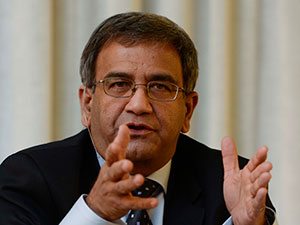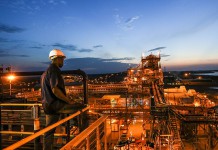
[miningmx.com] – ANGLOGOLD Ashanti, the R55.5bn gold producer, said there was “intense competition” among potential buyers for assets from which the firm said it wanted to divest either through a joint venture or an outright sale.
“It is a challenging environment,” said Srinivasan Venkatakrishnan, CEO of AngloGold Ashanti of the difficulty in attracting buyers for assets, but there had been “… intense competition from conventional and non-conventional players who want exposure to gold”.
AngloGold said last year it would consider bids for La Colosa, its Colombian property, as well as mines in West Africa such as Iduapriem and Obuasi, the latter currently the focus of a $209m downsizing and restructuring programme.
Venkatakrishnan said “work was underway”, but he declined to provide details of potential sales or joint ventures saying only its strategy was progressing. “We have not named any particular assets as they are operating mines with stakeholders involved,” he said.
He added, however, in questions following the presentation to analysts and media that AngloGold would prefer to cut a deal where it participated in gold price improvements through a royalty as per the sale of its Australian asset, Boddington.
Assets sales have been identified as one of the quickest means of reducing AngloGold Ashanti’s net debt which it had previously said it wanted to lower $1bn. Significantly, net debt was unchanged year-on-year in the firm’s 2014 annual figures at $3.13bn.
Venkatakrishnan said the company was not under pressure to complete any sales as it headroom with its banking facilities while its first bond maturity was not until 2020.
Yet the group has previously mentioned it had an interest in ‘calling’ a high interest bond from about June 2016 which currently costs the firm $107m in interest. It also said last year that if partners “earned-in’ to AngloGold assets, it could save up to $200m a year which is the cost of the interest on its total debt.
Barclays analyst, Andrew Byrne, said there was an “unwarranted” perception that AngloGold’s balance sheet was heavily stressed and that it had only 12 months to reduce net debt.
“We believe that the perception that AngloGold is suffering a liquidity challenge (even at US$1,100/oz gold prices) is unwarranted,” he said in a morning note.
Christine Ramon, CFO of AngloGold, described the net debt target as “aspirational” and that the group had two years to de-leverage its balance sheet. “We are absolutely not under any pressure,” she said.
AngloGold narrowed the loss attributable to equity shareholders to $58m in its 2014 financial year from $2.23bn in 2013. There was a headline loss of $79m (2013: $78m profit) and $1m loss in adjusted headline earnings from a $599m profit in 2013. Pre-tax earnings flat year-on-year at $1.67bn despite a 10% drop in the gold price.
AngloGold said it would produce between four million ounces to 4.3 million oz in its 2015 financial year down from 4.4 million oz in 2014 owing to the closure of Obausi’s underground mine and the sale of its Namibian mine, Navachab, last year.
Capital expenditure would be $1bn to $1.1bn, slightly lower than last year’s $1.2bn which was itself a 39% cut from 2013.
The group would also continue to rationalise its South African mines where the total head count had been reduced 14% since 2012, primarily through voluntary separation. Management numbers had been reduced a fifth over the same period.
Mines such as Great Noligwa and Moab Khotsong in the Vaal River region have been ‘merged’ in order to share services as part of the group’s ‘self-help’ initiative to lower costs and boost positive cash flow.
However, Venkatakrishnan rejected speculation that AngloGold would eventually face the recapitalisation of its South African assets. “I don’t think that is right for the South African business,” he said. “Mponeng, Tau Tona, and Moab Khotsong are strong cash generators,” said Venkatakrishnan.
The group was now looking at similar shared services between Kopanang and Moab Khotsong in its Vaal River region.
AngloGold took all in costs 22% lower in its 2014 financial year to $1,148/oz. It gave no forecast in its notes to its financial results for 2015 but said all in sustaining costs would be between $1,000/oz to $1,050/oz which compares to $1,026/oz in 2014.










